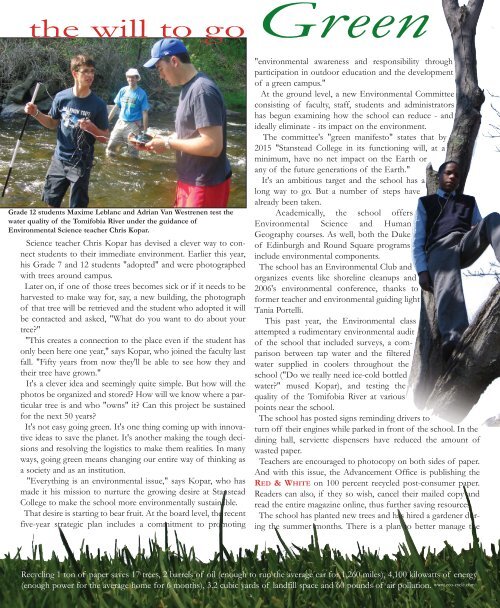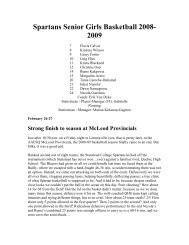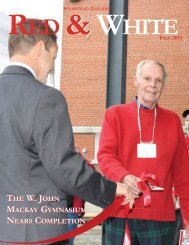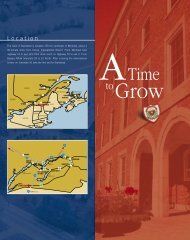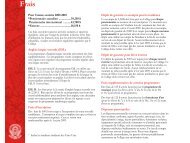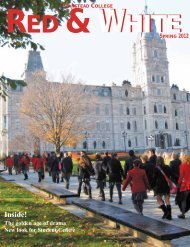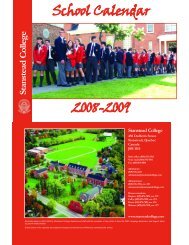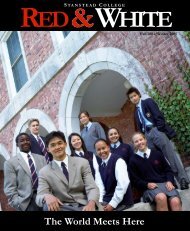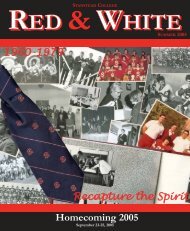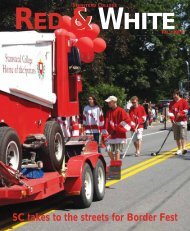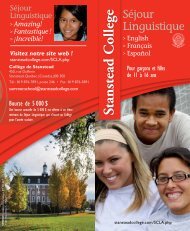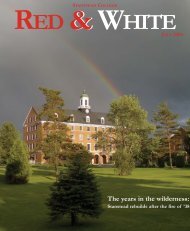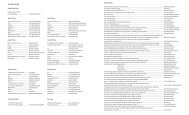2007B Fall.qxp - Stanstead College
2007B Fall.qxp - Stanstead College
2007B Fall.qxp - Stanstead College
Create successful ePaper yourself
Turn your PDF publications into a flip-book with our unique Google optimized e-Paper software.
the will to go Green<br />
Grade 12 students Maxime Leblanc and Adrian Van Westrenen test the<br />
water quality of the Tomifobia River under the guidance of<br />
Environmental Science teacher Chris Kopar.<br />
Science teacher Chris Kopar has devised a clever way to connect<br />
students to their immediate environment. Earlier this year,<br />
his Grade 7 and 12 students "adopted" and were photographed<br />
with trees around campus.<br />
Later on, if one of those trees becomes sick or if it needs to be<br />
harvested to make way for, say, a new building, the photograph<br />
of that tree will be retrieved and the student who adopted it will<br />
be contacted and asked, "What do you want to do about your<br />
tree"<br />
"This creates a connection to the place even if the student has<br />
only been here one year," says Kopar, who joined the faculty last<br />
fall. "Fifty years from now they'll be able to see how they and<br />
their tree have grown."<br />
It's a clever idea and seemingly quite simple. But how will the<br />
photos be organized and stored How will we know where a particular<br />
tree is and who "owns" it Can this project be sustained<br />
for the next 50 years<br />
It's not easy going green. It's one thing coming up with innovative<br />
ideas to save the planet. It's another making the tough decisions<br />
and resolving the logistics to make them realities. In many<br />
ways, going green means changing our entire way of thinking as<br />
a society and as an institution.<br />
"Everything is an environmental issue," says Kopar, who has<br />
made it his mission to nurture the growing desire at <strong>Stanstead</strong><br />
<strong>College</strong> to make the school more environmentally sustainable.<br />
That desire is starting to bear fruit. At the board level, the recent<br />
five-year strategic plan includes a commitment to promoting<br />
"environmental awareness and responsibility through<br />
participation in outdoor education and the development<br />
of a green campus."<br />
At the ground level, a new Environmental Committee<br />
consisting of faculty, staff, students and administrators<br />
has begun examining how the school can reduce - and<br />
ideally eliminate - its impact on the environment.<br />
The committee's "green manifesto" states that by<br />
2015 "<strong>Stanstead</strong> <strong>College</strong> in its functioning will, at a<br />
minimum, have no net impact on the Earth or<br />
any of the future generations of the Earth."<br />
It's an ambitious target and the school has a<br />
long way to go. But a number of steps have<br />
already been taken.<br />
Academically, the school offers<br />
Environmental Science and Human<br />
Geography courses. As well, both the Duke<br />
of Edinburgh and Round Square programs<br />
include environmental components.<br />
The school has an Environmental Club and<br />
organizes events like shoreline cleanups and<br />
2006's environmental conference, thanks to<br />
former teacher and environmental guiding light<br />
Tania Portelli.<br />
This past year, the Environmental class<br />
attempted a rudimentary environmental audit<br />
of the school that included surveys, a comparison<br />
between tap water and the filtered<br />
water supplied in coolers throughout the<br />
school ("Do we really need ice-cold bottled<br />
water" mused Kopar), and testing the<br />
quality of the Tomifobia River at various<br />
points near the school.<br />
The school has posted signs reminding drivers to<br />
turn off their engines while parked in front of the school. In the<br />
dining hall, serviette dispensers have reduced the amount of<br />
wasted paper.<br />
Teachers are encouraged to photocopy on both sides of paper.<br />
And with this issue, the Advancement Office is publishing the<br />
RED & WHITE on 100 percent recycled post-consumer paper.<br />
Readers can also, if they so wish, cancel their mailed copy and<br />
read the entire magazine online, thus further saving resources.<br />
The school has planted new trees and has hired a gardener during<br />
the summer months. There is a plan to better manage the<br />
Recycling 1 ton of paper saves 17 trees, 2 barrels of oil (enough to run the average car for 1,260 miles), 4,100 kilowatts of energy<br />
(enough power for the average home for 6 months), 3.2 cubic yards of landfill space and 60 pounds of air pollution. www..eco-cycle.com<br />
4


